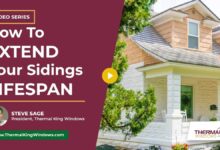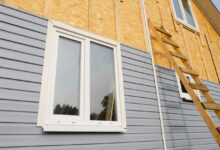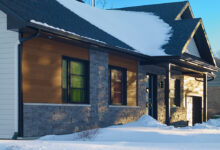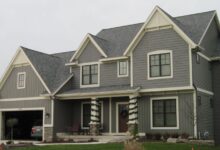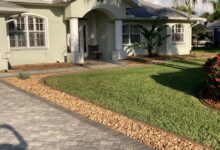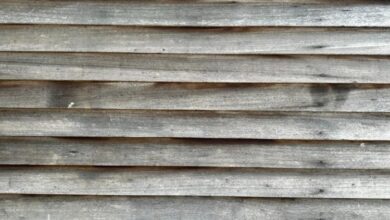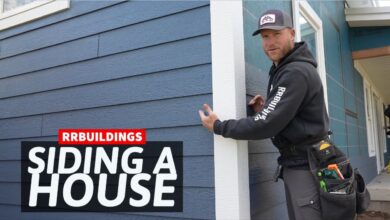Siding Design Ideas: Home Exterior Makeover
Siding Design Ideas to Make Your Home Stand Out in Your Neighborhood: Transforming your home’s exterior is a rewarding project, offering a fantastic opportunity to enhance curb appeal and increase property value. This guide explores various siding materials, color palettes, architectural integration techniques, and innovative design trends to help you create a stunning and unique home exterior that reflects your personal style while harmonizing with your neighborhood’s aesthetic. We’ll delve into the practical aspects of siding selection, from durability and maintenance to cost considerations, ensuring you make informed decisions throughout the process.
We’ll cover a range of topics, from understanding the properties of different siding materials like wood, vinyl, fiber cement, and metal, to mastering color theory and creating visually appealing color schemes for your home’s exterior. We’ll also explore how to strategically use siding to accentuate architectural details, create visual interest, and add depth and dimension to your home’s facade. Finally, we’ll showcase innovative siding trends and offer practical advice on how to balance individuality with neighborhood harmony in your exterior design choices.
Defining “Siding” Design
Siding is the exterior covering of a house, playing a crucial role in both its aesthetic appeal and its protection from the elements. Choosing the right siding material and style can significantly enhance your home’s curb appeal and increase its value. This section explores various siding options, their properties, and their visual impact.
Siding Materials and Their Aesthetic Qualities
A wide array of siding materials exists, each offering unique aesthetic qualities and performance characteristics. Wood siding, a classic choice, provides a natural, warm look that ages beautifully. Its texture and grain variations add character and depth. Vinyl siding, a popular and cost-effective option, offers a smooth, clean finish in a variety of colors and styles, mimicking the look of wood without the high maintenance. Fiber cement siding combines the durability of cement with the versatility of wood, providing a low-maintenance option with a realistic wood-grain texture. Metal siding, often made of aluminum or steel, offers exceptional durability and resistance to fire and insects, along with a modern, sleek aesthetic. Stone and brick, while not technically siding in the same sense, are also frequently used exterior cladding materials and offer a robust, timeless appeal.
Durability and Maintenance Requirements of Different Siding Types
The durability and maintenance requirements of siding materials vary considerably. Wood siding, while aesthetically pleasing, requires regular maintenance, including painting or staining every few years, to protect it from rot, insects, and weathering. Vinyl siding is exceptionally low-maintenance, requiring only occasional cleaning. Fiber cement siding is highly durable and resistant to rot, insects, and fire, needing minimal upkeep. Metal siding, similarly, is extremely durable and long-lasting, demanding little maintenance beyond occasional cleaning. Stone and brick, while requiring little to no maintenance beyond occasional cleaning, can be significantly more expensive upfront.
Popular Siding Styles and Their Visual Impact
Several popular siding styles significantly influence a home’s visual impact. Clapboard siding, characterized by its overlapping horizontal boards, creates a classic, traditional look. Shingle siding, with its varied lengths and textures, offers a more rustic and charming appearance. Board and batten siding, featuring wide vertical boards separated by narrower battens, creates a clean, modern aesthetic. Each style lends a unique character to a home, influencing its overall style and feel. For instance, a farmhouse might best utilize board and batten or shingle siding, while a more modern home might benefit from the clean lines of clapboard or even metal siding.
Comparison of Siding Materials
| Material | Cost | Durability | Maintenance |
|---|---|---|---|
| Wood | Medium to High | Medium | High |
| Vinyl | Low to Medium | Medium to High | Low |
| Fiber Cement | Medium to High | High | Low |
| Metal | Medium to High | High | Low |
Color Palette and Exterior Harmony
The color of your home’s siding significantly impacts its curb appeal and overall aesthetic. A well-chosen palette can enhance architectural details, create a welcoming atmosphere, and even increase property value. Conversely, an ill-considered color scheme can detract from the home’s beauty and make it appear dated or unappealing. Understanding color theory and its application to exterior design is crucial for achieving a harmonious and visually stunning result.
Color theory principles provide a framework for selecting siding colors that complement the roof, trim, and landscaping. Analogous colors (those located next to each other on the color wheel, such as blues and greens) create a calm and cohesive look, while complementary colors (those opposite each other on the color wheel, such as blue and orange) offer a more vibrant and dramatic contrast. The value (lightness or darkness) and saturation (intensity) of colors also play a vital role in the overall effect. Lighter colors can make a home appear larger and brighter, while darker colors create a more dramatic and sophisticated feel. Consider the amount of sunlight your home receives; a south-facing home might benefit from cooler colors to mitigate heat absorption.
Siding Color Choices and Their Coordination with Other Exterior Elements
Careful consideration should be given to the interplay between siding, roofing, trim, and landscaping. For instance, a dark gray siding might be paired with a lighter gray roof and crisp white trim for a modern and sleek appearance. Conversely, a warm beige siding could be complemented by a terracotta roof and brown trim for a more traditional and inviting feel. The landscaping should further enhance the color scheme, with plants and flowers that echo or contrast with the chosen hues. For example, a home with blue siding might incorporate blue-toned flowers or shrubs, while a home with red brick might feature complementary greens and yellows in the landscaping.
Examples of Successful Color Combinations for Different Architectural Styles
A Victorian home might benefit from a rich, deep green siding, accented with dark brown trim and a contrasting slate gray roof. The intricate detailing of the Victorian style is enhanced by the depth and richness of these colors. A Craftsman style home might be beautifully complemented by a warm, earthy tone siding, such as a muted brown or taupe, with darker brown trim and a green roof. This palette emphasizes the natural elements characteristic of Craftsman design. A contemporary home, on the other hand, might look striking with a clean, modern gray siding, paired with black or charcoal trim and a flat, light gray roof. This creates a sophisticated and minimalist aesthetic.
Mood Board: Three Distinct Siding Color Palettes
Palette 1: (Traditional Charm) Imagine a warm, inviting home with creamy beige siding, accented by deep brown shutters and trim. The roof is a dark brown, almost black, offering a strong contrast. Landscaping features lush green lawns and pops of yellow and orange flowers.
Palette 2: (Modern Minimalism) This palette presents a sleek, contemporary home with cool gray siding. Black window frames and trim provide a striking contrast, while a light gray roof maintains a cohesive look. Landscaping is simple, featuring gravel pathways and low-maintenance plants in shades of gray and green.
Palette 3: (Coastal Serenity) Picture a relaxed, coastal home with soft, light blue siding. White trim and a light gray roof create a bright, airy feel. Landscaping includes sandy-colored pathways, beach grasses, and white flowering plants, evoking a tranquil seaside atmosphere.
Integrating Siding with Architectural Details
Strategic siding choices can significantly enhance a home’s architectural features, creating a visually appealing and cohesive exterior. By carefully considering the interplay between siding and architectural details, homeowners can elevate their home’s curb appeal and overall aesthetic. This involves understanding how different siding materials, patterns, and colors can be used to highlight key elements and add depth to the home’s design.
Key architectural features, such as window frames, dormers, entryways, and bay windows, offer excellent opportunities for strategic siding application. These features can be subtly or dramatically emphasized using contrasting siding colors, textures, or patterns. For instance, a lighter-colored siding on the main body of the house can make darker-colored siding around windows and entryways stand out, creating visual interest and drawing the eye to these focal points. Similarly, the use of different siding textures, such as vertical lap siding on the main walls and horizontal shiplap siding on accents, can add depth and visual complexity to the facade.
Methods for Highlighting Architectural Details with Siding
Several methods exist for using siding to accentuate architectural details. One effective technique is to use contrasting colors. For example, a home with white clapboard siding might use a deep brown or charcoal gray siding around the windows and entryway to create a strong visual frame. Another approach is to employ different siding materials. A house primarily clad in vinyl siding could use stone or brick veneer around the base or entryway to add texture and visual weight. Furthermore, varying the siding pattern—such as using vertical siding on dormers and horizontal siding on the main walls—can add visual interest and depth.
Impact of Siding Patterns and Textures on Exterior Design
The choice of siding patterns and textures plays a crucial role in adding depth and dimension to a home’s exterior. Vertical siding creates a sense of height and elegance, while horizontal siding offers a more traditional and classic look. Combining different patterns, such as vertical siding on gables and horizontal siding on the main walls, can create a dynamic and visually engaging facade. Similarly, the texture of the siding material significantly impacts the overall aesthetic. Smooth siding offers a clean and modern look, while textured siding adds a rustic or traditional feel. The interplay of patterns and textures can significantly enhance the visual appeal of the home’s architectural details.
Visual Representation: Accenting a Bay Window and Front Porch
Imagine a two-story home with light beige vinyl siding. A bay window protrudes from the main structure. To highlight this feature, the bay window is clad in a darker beige, almost taupe, vinyl siding with a slightly textured surface. This creates a subtle contrast that draws attention to the bay window’s architectural form without being overly dramatic. The front porch, a prominent feature, is accentuated with a rich, dark brown wood-look composite siding. This creates a warm and inviting contrast against the lighter beige of the main house and further enhances the porch’s architectural significance. The difference in both color and material adds visual weight and emphasizes the porch as a key entry point.
Innovative Siding Design Trends
Home siding is experiencing a renaissance, moving beyond traditional choices to embrace innovative materials, textures, and applications. Modern siding design reflects a growing awareness of sustainability and a desire for unique, eye-catching exteriors that enhance curb appeal and property value. This section explores contemporary trends that are shaping the landscape of residential design.
Contemporary Siding Materials and Applications
The use of mixed materials is a prominent trend in contemporary siding design. This involves combining different siding types—for instance, combining sleek metal panels with warm wood accents or textured stone veneer with smooth fiber cement boards—to create visual interest and architectural depth. Vertical siding, traditionally associated with older homes, is enjoying a resurgence, offering a modern, streamlined aesthetic that contrasts with the more horizontal orientation of traditional clapboard. Accent panels, strategically placed on gables, entryways, or around windows, add a pop of color or texture, drawing the eye and highlighting architectural features. These elements are used in a variety of creative ways, often highlighting modern minimalist design or adding pops of color against a neutral backdrop. For example, a home might feature primarily fiber cement siding in a light gray, with vertical cedar planks accentuating a prominent window bay and dark metal panels outlining the entryway.
Sustainable and Eco-Friendly Siding Options
The demand for environmentally conscious building materials is driving the popularity of sustainable siding options. Recycled materials are increasingly used in siding production, minimizing environmental impact. For example, some manufacturers produce siding from recycled plastic or reclaimed wood, offering a durable and eco-friendly alternative to traditional materials. Rapidly renewable materials, such as bamboo, are also gaining traction, providing a sustainable and aesthetically pleasing option. Furthermore, the use of low-VOC (volatile organic compound) paints and stains further minimizes the environmental footprint of siding installations. The selection of sustainable siding not only reduces the carbon footprint of a project but also contributes to a healthier living environment.
Unique Siding Applications for Modern Exteriors
Beyond material selection, innovative siding applications contribute significantly to a home’s modern aesthetic. The use of large-format siding panels minimizes visible seams, creating a clean, uncluttered look. Varying the orientation and size of siding panels can add visual dynamism to a façade. For example, a combination of horizontal and vertical siding, or the use of oversized panels on a portion of the wall, can break up large expanses of siding and add visual texture. Strategic use of shadow lines and recessed panels can also create depth and visual interest. Integrating lighting into siding panels adds another layer of sophistication, subtly illuminating architectural features and enhancing nighttime curb appeal. Consider a home with a combination of large, dark gray fiber cement panels, contrasted by smaller, lighter-colored panels forming a geometric pattern around the windows and entryway.
Five Innovative Siding Design Ideas
The following list provides five innovative siding design ideas, each showcasing a unique approach to enhancing a home’s exterior:
- Mixed Material Modernity: Combine sleek metal panels with warm wood accents for a contemporary contrast. Imagine a home with dark gray metal siding on the lower level, transitioning to cedar wood siding on the upper level, creating a visually interesting interplay of textures and materials.
- Vertical Emphasis: Utilize vertical siding to create a tall, slender appearance, particularly effective on narrower homes. This creates a modern, streamlined look, offering a refreshing departure from traditional horizontal siding.
- Accent Panel Pop: Incorporate vibrant accent panels to highlight architectural features like entryways or window bays. For example, a bold red accent panel could draw attention to a modern front door, contrasting beautifully with a neutral-toned main siding.
- Sustainable Style: Opt for recycled plastic or bamboo siding for an environmentally friendly choice. These sustainable materials provide durability while reducing the environmental impact of the construction process.
- Geometric Play: Use varied siding panel sizes and orientations to create a visually engaging geometric pattern. This could involve a combination of horizontal and vertical panels in varying sizes and colors to create a unique and striking façade.
Creating a Cohesive Exterior Design
Selecting siding that complements your home’s architecture and integrates seamlessly with its surroundings is crucial for creating a cohesive and visually appealing exterior. Careful consideration of your neighborhood’s aesthetic and the balance between individuality and harmony will ensure your home stands out in a positive and tasteful way.
Neighborhood aesthetic significantly influences the overall curb appeal of a home. Choosing siding that aligns with the prevailing architectural styles and color palettes of the surrounding houses fosters a sense of community and enhances the property values within the neighborhood. Conversely, starkly contrasting siding choices might create visual dissonance and detract from the overall harmony of the area.
Balancing Individuality and Neighborhood Harmony
Achieving a balance between expressing your personal style and respecting the established aesthetic of your neighborhood requires a thoughtful approach. While mirroring your neighbors’ choices exactly isn’t necessary, selecting siding materials and colors within a similar range ensures visual compatibility. For example, if most homes in the neighborhood feature traditional clapboard siding, choosing a modern fiber cement siding in a complementary color would strike a balance. This approach allows for individuality in material and texture while maintaining visual harmony through color choices. A home with a vibrant, unconventional siding color might stand out too much, potentially clashing with the neighborhood’s character.
Landscaping and Hardscaping to Complement Siding
Landscaping and hardscaping elements play a vital role in tying together the various aspects of your home’s exterior design. The careful selection of plants, pathways, and other features can significantly enhance the overall aesthetic impact of your siding choices. For instance, a home with light-colored siding might benefit from lush greenery, providing a calming contrast. Conversely, a home with dark siding might look striking with the use of stone pathways and drought-tolerant landscaping, creating a sophisticated and harmonious look. The textures and colors of these elements should complement, not compete with, the siding. For example, a home with rough-hewn stone siding might be complemented by a rock garden and gravel pathways, while smooth stucco siding might pair well with manicured lawns and neatly trimmed hedges.
Integrating Lighting to Enhance Visual Appeal
Strategic lighting can dramatically enhance the visual appeal of a home’s exterior, particularly when used to highlight the siding. Warm, ambient lighting can accentuate the texture and color of the siding, creating a welcoming atmosphere. Uplighting can draw attention to architectural details, such as dormers or columns, while downlighting can illuminate pathways and landscaping features, creating a sense of depth and dimension. Consider using path lighting to highlight the textures of stone walkways or the colors of flowerbeds, thereby tying the landscaping and hardscaping elements to the overall siding design. Well-placed spotlights can also showcase unique features of the siding itself, such as intricate patterns or varied textures. The strategic use of lighting creates visual interest and emphasizes the carefully chosen siding, enhancing the home’s curb appeal, especially at night.
End of Discussion
Ultimately, choosing the right siding for your home involves a careful consideration of aesthetics, practicality, and budget. By understanding the diverse options available and applying the design principles discussed, you can create an exterior that not only stands out but also enhances the overall value and appeal of your property. Remember, the goal is to create a cohesive and visually stunning home exterior that reflects your personal style and complements your neighborhood’s character. With careful planning and attention to detail, your home can become the envy of the block.
